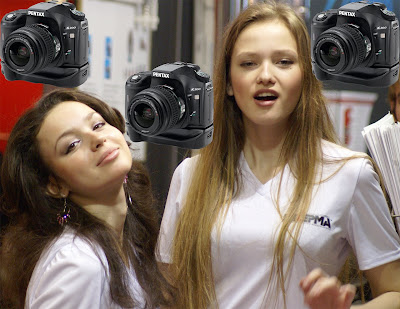 In comparison with newest entry-level Digital SLR cameras such as the Nikon D60, the Sony A200, the Olympus E420 and old-fashion Canon Rebel Xti, the new Pentax K200D looks quite good. After Pentax K100D / K100 Super, this solidly constructed SLR camera with weather and dust resistant body can impress even advanced photographers, who are interested in serious cameras as the Canon EOS450 / Rebel Xsi or the Sony A300 / A350.
In comparison with newest entry-level Digital SLR cameras such as the Nikon D60, the Sony A200, the Olympus E420 and old-fashion Canon Rebel Xti, the new Pentax K200D looks quite good. After Pentax K100D / K100 Super, this solidly constructed SLR camera with weather and dust resistant body can impress even advanced photographers, who are interested in serious cameras as the Canon EOS450 / Rebel Xsi or the Sony A300 / A350.
The Pentax K200 as a step-up of entry-level SLR
Sure, the Pentax K200D is strep of some cool features such as the Live-View mode (Olympus E420, Sony A300) and its ability for using AA batteries is a little questionable. However, the combination of high-speed aperture, in-body stabilization system, waterproof body ( it's a really cool feature, especially for my Sauna-blog), and low-noise high ISO means me much interesting that the Live View LCD, which only enables photographers to hold the camera away from their faces. Although the K200D designed mainly for family users and beginners, this SLR has a host of useful features and functions like any higher-class models.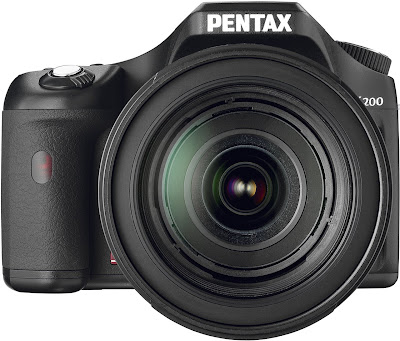 Pentax K200D main features
Pentax K200D main features
- Shake Reduction feature incorporating a 10.2 megapixel CCD is compatible with any Pentax lens ever produced, including SDM lenses, minimizes the effect of camera shake
- Auto Picture and Scene modes offer shooting ease, while advanced modes, such as the Sv mode, allow photographers to grow with the camera
- 2.7 inch high resolution, wide view LCD panel allows easy review of pictures, while including enlarged menu lettering
- Weather and dust resistant body allows you to keep shooting even in harsh conditions
- Includes long life Energizer AA Lithium batteries for the perfect combination of long life and easy to find replacements
- Advanced 16-segment metering and 11-point AF, with 9 cross sensors, ensure perfectly exposed and focused images
- PRIME (PENTAX Real Image Engine) image processing engine maximizes image properties and allows custom adjustment of image parameters
- Custom Image modes, with six preset options, offer superior control of how the PRIME processor develops images
- Enhanced Dynamic Range mode gives 200% more dynamic range
Optical Image Stabilizer
As in case of the Sony A200 (for more look at the previous post) and Olympus E510 / E420, main improvements comparing to previous Pentax K100 is in-body optical stabilization system. For more details about Olympus's SLRs look at Olympus SLRs: E330, E400, E410, E500 and E510. Can pop-cams fight vs. Nikon D80 or Canon XTi?. Pentax is using sensor shift stabilization (where the sensor is moving-shifting to compensate the movement of camera body) what means that you do not need an optically stabilized lens and can use any lenses you want. This mechanism shifts the position of the CCD image sensor vertically and horizontally at high speed using magnetic force, while adjusting the shifting speed in proportion to the amount of camera shake detected by a built-in sensor. It offers a compensation effect, equivalent to approximately 2.5 to 4 shutter-speed steps. Sure, the Pentax lens collection is not as big as Nikkor and Canon. In addition, its quality is an excellent and you can get more than enough from Pentax and do not look at some manufacturers as Sigma and Tamron.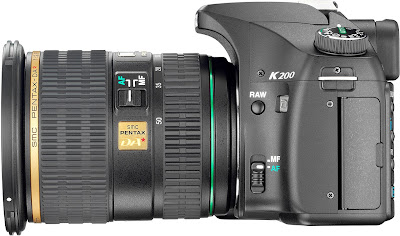 Pentax K200D specifications
Pentax K200D specifications
- Interline interlace CCD with primary color filter and integrated Shake/Dust Reduction sensor movement system; Size - 23.5 x 15.7mm; Color depth - 8 bits/channel JPG, 12 bits/channel RAW; Effective pixels - 10.2 MP; Total pixels - 10.75 MP; Recorded resolutions - 3872x2592 (10M), 3008x2000 (6M), 1824x1216 (2M) Quality levels: Best, Better, Good; Dust removal - Image sensor movement combined with SP coating
- Body-based, sensor shift Shake Reduction image stabilizer system - max 4 stops
- Pentax KAF2 bayonet stainless steel mount; Usable lenses - Pentax KAF2, KAF, and KA (K mount, 35mm screw mount, 645/67 med formats useable w/ adapter and/or restrictions)
- TTL phase-matching 11 point wide auto focus system, Focus modes - AF Single (w/focus lock), Manual, AF Continuous available in Action mode (including Auto Pict Action), Kids mode, Pet mode, P/A/S/M/B/Sv; Focus point adjustment - Auto, User-Selectable, Center; AF assist, via built-in flash
- Penta-Mirror viewfinder; Coverage (field of view) - 96%, Magnification - 0.85x (w/ 50mm f/1.4 at infinity), Standard focusing screen - Natural-Bright-Matte II, Diopter adjustment - -2.5 to 1.5, Depth of field preview - Optical diaphragm stop down, Digital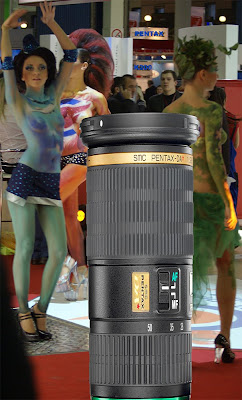 - 2.7” TFT colors LCD monitor, adjustable brightness, 230,000 pixel; wide angle viewable, approx 160 degrees horizontal/vertical
- 2.7” TFT colors LCD monitor, adjustable brightness, 230,000 pixel; wide angle viewable, approx 160 degrees horizontal/vertical
- Continuous Drive at 2.8 fps, up to 4 JPEG, 1.1 fps, RAW
- Retractable P-TTL popup flash, Guide number - 13 (100/m), Coverage - 28mm wide angle (equivalent to 35mm), Flash modes – TBA, Flash exposure compensation -2 to 1 EV in 1/2 steps
- Removable memory - SD, SDHC
- USB 2.0 hi-speed, DC input, cable switch, Video out - NTSC, PAL, Printer interfaces – PictBridge
- 4 AA (lithium, alkaline, NiMH rechargeable), Recordable images - Approx 1100 w/lithium (approx 550 w/ 50% flash use), Playback time - Approx 700 min; optional AC adapter
- ISO Sensitivity: Auto - 100-1600 ISO (1, 1/2, 1/3 steps), Manual - 100-1600 ISO (1, 1/2, 1/3 steps)
- TTL open aperture, 16 segment metering; Sensitivity range - EV 0-21 (ISO 100, 50mm f/1.4); Multi-segment, 16 segments; Center weighted, Spot, Exposure compensation - +/- 2 EV (1/2 or 1/3 steps); Exposure lock, Exposure bracketing, 3 frames, up to +/- 1.5 (1/2 steps) or +/- 1.0 (1/3 steps)
- Electronically controlled, vertical run, focal plane shutter; Shutter speed - 1/4000 to 30 sec, bulb available
- File Formats: RAW PEF/DNG, JPG (EXIF 2.21), DCF 2.0 (design rule for camera file system), DPOF, and Print Image Matching III
- Weight (inc. batteries) 690g - 24.3 oz w/lithium batteries (25.6 oz w/alkaline batteries), 22.2 oz without battery
- Dimensions 134 x 95 x 74 mm (5.3 x 3.7 x 2.9 in)
- Construction material - Reinforced plastic polymer shell around a rugged stainless steel chassis, operating temperature - 32-104 degrees F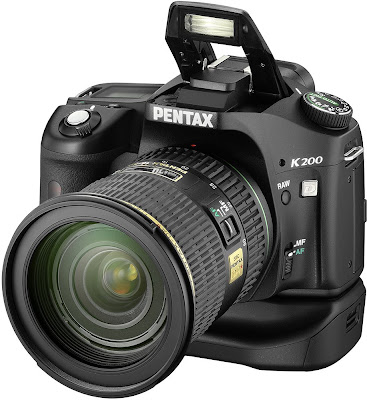 Pentax K200D pros and cons
Pentax K200D pros and cons
The same as the Pentax K10D an excellent weatherproof construction body with some features and great image quality makes the Pentax K200D very attractive for advanced users. However, its weight and dimensions give the best fit for next-level digital SLR cameras. In comparison with the Nikon D60 (522 g), Sony A200 (572 g) and Olympus E420 (440 g), the K200D with its 690 g body is not so good for family shooting. Moreover, for sport shooting where you need a fast frame rate and a long Tele lens, you should consider a speedy camera. However, for those who need an excellent picture quality the Pentax K200D is a right choice.
Pros:
- Goog and solid build quality, feels more expensive than any entry-level SLR
- Excellent image quality
- Good, low-noise performance at high ISO even at ISO 1600
- Weather sealed body
- Good 18-55mm Kit lens
- Very effective in-body image stabilization system
Cons:
- Small buffer at 2.8 fps, up to 4 JPEG, 1.1 fps, RAW
- Not so small and lightweight as I'd like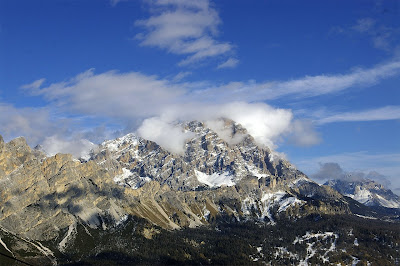 Conclusion
Conclusion
Looking through the Nikon D60 ($690 with 18-55mm Lens Kit, for any details look through Nikon D60 vs. Canon Xti, Sony A200, Pentax K200 and Olympus E510), Olympus E410 / E510 / E420 ($790 with 14-42mm Lens Kit), Sony A200 ($550 with 18-70mm Lens Kit) / A300 ($950), Canon Rebel Xti ($510) / Xsi ($1130 with 18-55mm Lens Kit), and of course the Pentax K200D it’s hard to find the worst camera as well as the best. All of these SLRs have some pros and some cons. Nevertheless, small 4/3 Olympus with excellent Zuiko lenses, famous Nikon and Canon, rich of features Sony etc. have they own users and admirers. For more look at Canon EOS400/XTi, Nikon D40x and Pentax K10 pros& cons; SLR over SLR-like triple benefits. As for the Pentax K200D, this SLR ($800 with 18-55mm Lens Kit) is good for traveling through dusty or damp climate countries. For those who rate the image, construction and lens quality highly than lightweight, Live View ability and brand name.
Thursday, March 27, 2008
Pentax K200D vs Sony A200 / A300; Weather resist SLR vs. Live-View
Автор
fototramp
на
12:01 PM
11
комментария(ев)
![]()
Tuesday, March 25, 2008
Sony A200 vs Pentax K200 or Nikon D60 – what’s new in Sony’s SLR
 This year brings some new and interesting gadgets to the entry level DSLR’s market. There are Nikon D60, Pentax K200D and Sony A200 with 10MP APS-C sensor, low image noise, very fast shutter lag numbers and any cool features such as image stabilizer system, anti-dust and even weather-sealed body (Pentax K200). As for Canon, its new Digital SLR – the EOS Digital Rebel Xsi with 12MP 22.2 x 14.8 mm CMOS sensor is a little higher to these three and it requires a special article. For more details look at Pentax K200D vs Sony A200 / A300; Weather resist SLR vs. Live-View.
This year brings some new and interesting gadgets to the entry level DSLR’s market. There are Nikon D60, Pentax K200D and Sony A200 with 10MP APS-C sensor, low image noise, very fast shutter lag numbers and any cool features such as image stabilizer system, anti-dust and even weather-sealed body (Pentax K200). As for Canon, its new Digital SLR – the EOS Digital Rebel Xsi with 12MP 22.2 x 14.8 mm CMOS sensor is a little higher to these three and it requires a special article. For more details look at Pentax K200D vs Sony A200 / A300; Weather resist SLR vs. Live-View.
Sony DSLR Alpha-200 main features
I am shooting with the Sony A100 for a long time and I felt its pros and cons on one's own back. Naturally, the appearing of Alpha 100’s upgrade version – the Sony A200 made me interest in its abilities. Let’s look around the gadget for better understanding what’s make the Alpha 200 speedy, low-noisy and much attractive than predecessor.
- Super Steady Shot in-camera image stabilization system offers from 2.5 to 3.5 stops of compensation
- Dynamic Range Optimizer: Normal DRO improves detail using standard gamma curves for fast shot-to-shot response time. Advanced DRO adjusts dynamic range area-by-area - Bionz Image Processor
- Bionz Image Processor
- Anti-Dust Technology
- Auto Pop-Up Flash with four main operating modes and a variable Slow-Sync function
- External, proprietary flash hot-shoe for Sony accessory flash units
- Built-in support for wireless TTL flash exposure with certain Sony flashes
- Eye-Start Auto focus System
- 9-Point Center Cross AF Sensor
- Auto and Manual focus options with Single and Continuous AF modes
- 40-segment honeycomb metering system, plus Center-Weighted and Spot metering options, with AE Lock function
- Scene Selection Modes: Portrait, Landscape, Macro, Sports, Sunset and Night Portrait/Night View situations
- RAW and JPEG file formats
- Contrast, saturation, and sharpness adjustments
- Adjustable White Balance setting with presets and a manual option, as well as a full range of Kelvin temperature settings
- Index and Slide Show Display
- High-Resolution Thumbnails for Photo TV HD Viewing
- NTSC / PAL selectable video output signal, with cable included
- Function Guide Display
- Continuous Burst Mode at three frames per second
- "Storage-Class" USB 2.0 High-Speed interface
- USB 2.0 High-Speed cable and interface software for connecting to a computer and downloading images
- DPOF (Digital Print Order Format), Exif 2.2, Print Image Matching III and PictBridge compliant What’s new in the Sony A200
What’s new in the Sony A200
As in case of the A100, the Sony A200 has a CCD-shift Anti-Shake platform (now named Super Steady Shot), Anti-Dust technology and Bionz image processor. What for Dynamic Range Optimizer, let’s look through the Sony A-100 review:
Sony’s Dynamic Range Optimizer (DRO) analyzes the captured image data and instantly determines the best exposure and color tonality of an image before JPEG compression. Unlike software optimization of a processed image, DRO is performed in the hardware. It is the first hardware-based DRO solution with the speed required for high-speed shooting.
In comparison with the Sony A-200 review, it is hard to understand what is new.
An evolved new D-Range Optimizer helps ensure even more beautifully balanced exposures in backlit situations. In Standard mode, it optimizes brightness and contrast for the image overall, and in Advanced mode, it optimizes each area of the composition separately to bring out maximum shadow and highlight detail. The D-Range Optimizer can be used on all image formats in all metering modes.
However, there is a fact that the new Alpha 200 is speedy, easy to use and has better image quality than the A-100, especially in low light situations. The Sony A200's high ISO of 3,200 has noise and softness due to noise suppression, but in case of the A-100, I have a nasty noise at ISO 400 and higher. Sony Alpha 200 upgraded features include:
Sony Alpha 200 upgraded features include:
- Wider, 2.7-inch Clear Photo LCD screen for easy playback viewing
- More compact body and an easily accessible mode dial
- Easy-to-use function menu (camera function display)
- Improved noise control for higher quality images
- Auto focus speed 1.7x faster than the A-100
- Improved predictive control performance
- Quieter shutter sound
- Automatic pop-up flash
- Battery life indicator that displays the percentage of battery life remaining so you know exactly when to recharge
Sony A200 specifications
- 23.6 x 15.8 mm Interline interlaced CCD sensor with Built-in fixed low-pass filter
- 10.8 million total and 10.2 million effective pixels
- 1.5x FOV crop
- Image size at aspect ratio 3:2 -- L size: 3872 x 2592 (10M), M size: 2896 x 1936 (5.6M), S size: 1920 x 1280 (2.5M)
- Aspect ratio 16:9 -- L size: 3872 x 2176 (8.4M), M size: 2896 x 1632 (4.7M), S size: 1920 x 1088 (2.1M)
- ISO Sensitivity: 100 to 3200
- 1/160 sec Flash X-sync
- RAW, RAW + JPEG, Fine, Standard image quality modes
- CompactFlash (Type I, Type II), Microdrive; Separately sold "Memory Stick Duo Adapter for CompactFlash Slot AD-MSCF1" is necessary for use with Memory Stick Duo / Memory Stick PRO Duo / Memory Stick PRO-HG Duo
- Long exposure Noise Reduction: On/Off selectable, available at shutter speeds longer than 1 sec., High ISO NR: On/Off selectable, available at ISO 1600 or higher
- Electronically-controlled, vertical-traverse, focal-plane shutter type
- Shutter Speed at 1/4000 to 30 sec., Bulb
- 2.7-inch 230,000 pixels Clear Photo LCD Screen
- Optional VG-B30AM vertical grip accepts up to 2x NP-FM500H batteries
- Dimensions: 5.2 x 3.7 x 2.8in (133 x 95 x 71mm)
- Weight: No battery: 532 g (1.2 lb), 625g (22 ounces) with lens, battery, and card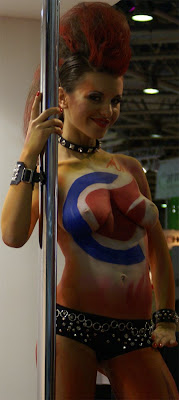 Sony A200 pros and cons
Sony A200 pros and cons
Sure, the new Sony A-200 makes A100’s owners envious of some its features. At the same time, there are some A-100’s pros, which the new Alpha succeeded.
Pros:
- Inexpensive price
- Compact, solid feel body
- Excellent hands grip
- Great 10.2-megapixel sensor
- Function button makes access to commonly used functions easy
- Useful menu design
- Dynamic Range Optimization works well, preserving detail in highlights and shadows
- Excellent shutter lag numbers
- Very good low light / high ISO performance
- Eye-Start Auto focus System, fast auto focus
- Auto pop-up flash great for full-auto shooters
- Super Steady Shot image stabilization system works well, allows to use cheap, non- stabilize lenses
- Fast USB transfer speed
- Excellent battery life
However, nothing is perfect and as a majority of new gadgets, the Sony A-200 has some cons too.
Cons:
- Dynamic Range Optimization works well, but slow down the camera
- The same as A-100 kit (18-70mm and 75-300mm) lenses with well-known (slightly soft in corners and in macro performance) troubles
- Pop-up flash is a little slowly
- Slow startup
- Some Auto White Balance troubles in bright light
- Really excellent Carl Zeiss lenses costs so much, seemingly better to look at Olympus Conclusion
Conclusion
The new Sony DSLR A200 is a good plodder for adequate price ($700 for Kit and $900 for double: 18-70mm and 75-300mm Kit). With its advanced features, the Sony A-200 would be winning. However, Nikon contrives to shoot without noise with the same Sony’s sensor as in case of D80, D300 and D60. For more details about the Nikon D60 look through my previous post. As for lack of a focus drive in the Nikon D60, it is not a trouble. There are many special designed Nikkor lenses with motors. Of course, it needs a lot of money, but not so much. Instead, the Pentax K200D with weather-sealed body seems me very interesting, especially for journeys. As for Canon Rebel XTi / EOS400, look through: Canon EOS400/XTi, Nikon D40x and Pentax K10 pros& cons; SLR over SLR-like triple benefits. In any case, an entry level SLRs choice is wide. So be it.
Автор
fototramp
на
8:02 AM
7
комментария(ев)
![]()
Monday, March 24, 2008
Nikon D60 vs. Canon Xti, Sony A200, Pentax K200 and Olympus E510
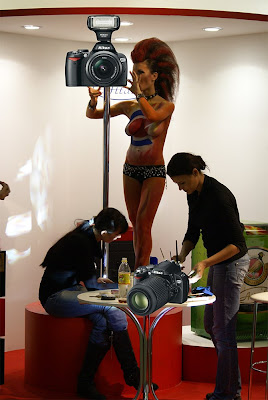 After the Nikon D40 appearing in 2006 and its 10 megapixels latest upgrade – the Nikon D40x, the D60 is the third incarnation of Nikon's “cheap” entry-level SLR line, which replaced the first Nikon 'starter' model, the D50. Sure, this new digital SLR camera is a true Nikon with many good features. However, the fact that “Auto Focus only for AF-S or AF-I lenses” doubt whether makes D60’s users happy.
After the Nikon D40 appearing in 2006 and its 10 megapixels latest upgrade – the Nikon D40x, the D60 is the third incarnation of Nikon's “cheap” entry-level SLR line, which replaced the first Nikon 'starter' model, the D50. Sure, this new digital SLR camera is a true Nikon with many good features. However, the fact that “Auto Focus only for AF-S or AF-I lenses” doubt whether makes D60’s users happy.
Nikon D60 vs. Canon Digital Rebel Xti, Pentax K200, Olympus E510 or Sony Alpha 200
There are a lot of not bad entry-level SLRs such as Canon EOS 400D, Sony A200 and Pentax K200D with many advantages, which can’t make the D60 beyond comparison. The latest Alpha digital SLR from Sony, the A200 has a ten-megapixel APS size CCD (from Sony), Super SteadyShot sensor-shift image stabilization system, three frames per second continuous shooting, Sony's Dynamic Range Optimizer (DRO) and a 2.7 inch 230,000 pixel LCD monitor for $700 with 18-70 mm kit lens. For any details look through Sony A200 vs Pentax K200 or Nikon D60 – what’s new in Sony’s SLR.
The Pentax K200D offers a host of user-friendly features and sophisticated functions such as weather-sealed body, CCD-based anti-shake and dust removal. This SLR has the same APS-C sized (23.5 x 15.7 mm) sensor with 10.2 million sensor photo detectors. For more: Pentax K200D vs Sony A200 / A300; Weather resist SLR vs. Live-View.
As for well-known Canon Digital Rebel Xti (EOS 400D), the 22.2 x 14.8 mm CMOS nine-point AF sensor from the EOS 30D, a new dust removal system which includes anti-static surface coatings, low-pass filter vibration and software based dust pattern removal are not many impressive than an anti-dust system that incorporates a self-cleaning sensor unit that shakes off dust, coupled with an airflow system designed to channel dust away from the D60’s sensor.
As for Olympus SLRs, it's better to look through Compare digital SLR cameras: Olympus E-1, E-400 vs. Nikon D80, D40x or Pentax K10D; 4/3” sensor rules in Pro hands. Nikon D60 main features
Nikon D60 main features
Let’s look through D60’s cool features.
- 10 megapixel 23.6 x 15.8 mm sensor, Nikon DX format CCD (1.5x FOV crop)
- Nikon EXPEED* image-processing concept such as D300 and D3
- 12-bit A/D converter
- 3D Color Matrix Metering II, 420 pixel sensor
- Multi-CAM530 three-area AF sensor
- New Image sensor cleaning system
- Eye sensor, which turns off LCD display
- ISO sensitivity range 100 - 1600 plus HI 1; 3200 equiv
- 3.0 fps continuous shooting (slower with noise reduction enabled), unlimited in JPEG
- Large 2.5" 230,000 pixel LCD monitor with help suggestions
- Short shutter lag and viewfinder blackout
- Support for SDHC (SD cards over 2 GB in capacity)
- In-camera retouching
- USB 2.0 with PTP and Mass Storage device support * The Nikon D60 uses EXPEED technology to maximize image quality and processing speed. These features designed to allow the optimisation and adjustment of images without the need for a computer. Image optimisation is achieved through functions like Active D-Lighting, which compensates for strong shadows, and the automatic correction of false eye colour when using the built-in flash. Creative features include the automated creation of stop-motion animation files from a sequence of images, and effects that simulate the use of optical filters to produce colour shading and sparkling highlights.
* The Nikon D60 uses EXPEED technology to maximize image quality and processing speed. These features designed to allow the optimisation and adjustment of images without the need for a computer. Image optimisation is achieved through functions like Active D-Lighting, which compensates for strong shadows, and the automatic correction of false eye colour when using the built-in flash. Creative features include the automated creation of stop-motion animation files from a sequence of images, and effects that simulate the use of optical filters to produce colour shading and sparkling highlights.
Nikon D60 differences from the D40x
- Image sensor-cleaning system
- Airflow control system
- Automatic defeat via Eye Sensor
- Automatically rotating user interface for using vertically orientated camera
- Stop motion movie playback function
- New stabilized kit lens AF-S DX NIKKOR 18-55mm f/3.5-5.6G VR
- Active D-Lighting with dedicated button
- In-camera Raw processing
- JPEG retouches effects Nikon D60 specifications
Nikon D60 specifications
- 23.6 x 15.8mm CCD sensor
- 10.2 million effective, 10.8 million total pixels
- 3872 x 2592 -- Large, 10.0 MP; 2896 x 1944 -- Medium, 5.6 MP; 1936 x 1296 -- Small, 2.5 MP image sizes
- Equivalent in 35mm (135) format is approx. 1.5X lens focal length
- Eye-level penta-prism mirror single-lens reflex viewfinder
- 3 frames per second continuous shooting speed at full resolution
- 2.5" TFT LCD 230,000 pixel
- Combined mechanical and CCD electronic shutter 30 to 1/4000 sec (1/3 EV steps)
- USB 2.0 (Hi-Speed), Mass storage / PTP selectable, Video out, DC-IN (optional AC adapter) connectivity
- Nikon F mount lenses: AF-S and AF-I NIKKOR: All functions supported; Type G or D AF NIKKOR not equipped with an autofocus motor: All functions supported except autofocus; Type G or D AF NIKKOR not equipped with an autofocus motor: All functions supported except autofocus; IX-NIKKOR and AF-NIKKOR for F3AF not supported; Type D PC NIKKOR: All functions supported except some shooting modes
- Dimensions: 126 x 94 x 64 mm (5.0 x 3.7 x 2.5 in)
- Weight (no/inc. batt) 471 g (1.0 lb)/ 522 g (1.2 lb)
- Optional Accessories: ML-L3 Wireless Remote Control, Capture NX, Camera Control Pro 2, EP-5AC Adapter Connector, EH-5a AC Adapter, EG-D100Video Cable, CF-DC1 Semi-Soft Case, Speedlight SB-800, SB-600, SB-400, R1C1
- Supplied Accessories: EN-EL9 Rechargeable Li-ion Battery, MH-23 Quick Charger, UC-E4 USB Cable , DK-20 Rubber Eyecup, AN-DC1 Camera Strap, BF-1A Body Cap, DK-5 Eyepiece Cap, BS-1 Accessory Shoe Cover, Software Suite CD-ROM Nikon D60 pros and cons
Nikon D60 pros and cons
Of course, none of this information can give a full view on the Nikon D60. However, there are some pros and cons, whith can be usefull for buyers.
Pros:
- This is Nikon’s cheapest DSLR
- This is a Nikon camera that is a pleasure to use
- A very good kit lens
- Effective image stabilisation system
- Hight image quality with good sharp and contrast
Cons:
- No focus drive in a camera body as in case of the D40/D40x
- No exposure and white balance bracketing
Conclusion
First of all the D60 is a Nikon with its high quality of work, excellent ergonomics, lightweight body and great quality images. Sure, the Nikkor range of auto-focus lenses available for this camera is limited. However, 18-55 mm and 55-200 mm twin lens kit is more than enough for a majority of photographers. At the same time, there are many new lenses with in built focus motors from Sigma, Tamron etc. As for comparison with the Canon Xti (Canon EOS400/XTi, Nikon D40x and Pentax K10 pros& cons; SLR over SLR-like triple benefits), Pentax K200, Sony A200 and Olympus E510, all of these 10MP cameras have its own pros and cons, different prices and different lenses. For making a right choise, it is better to get acqainted with these Digital SLR cameras by youself. For it bother all salesmen you can rich. Let you trouble be their trouble.
Автор
fototramp
на
10:08 AM
3
комментария(ев)
![]()
Wednesday, February 20, 2008
Casio Exilim EX-F1 as fastest digital SLR-like camera with CMOS sensor, better than Canon S5 and Panasonic TZ3
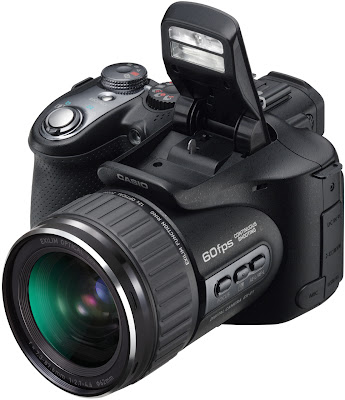 After SONY’s great ultra zoom camera – DSC-R1, the new Casio EXILIM Pro EX-F1 is the next SLR-like camera with CMOS sensor. However, good guys from Casio made a clever step with this gadget. They do not want to run for useless mega pixels and put 6.6 million total pixels into 1/1.8 inch sensor. As a result, the Casio EX-F1 can shoot at an ultra fast speed - 60 frames per second.
After SONY’s great ultra zoom camera – DSC-R1, the new Casio EXILIM Pro EX-F1 is the next SLR-like camera with CMOS sensor. However, good guys from Casio made a clever step with this gadget. They do not want to run for useless mega pixels and put 6.6 million total pixels into 1/1.8 inch sensor. As a result, the Casio EX-F1 can shoot at an ultra fast speed - 60 frames per second.
Casio EX-F1 features
Let us look around Exilim EX-F1 features for better understanding, how this gadget can shoot speedy than a digital SLR camera. For more details look through Choosing a Digital SLR: Nikon D40s vs D300 or maybe FinePix S8000 vs Fujifilm S5 IS Pro.
6.6 Mega pixels with 12X Optical zoom
The EXILIM Pro EX-F1 incorporates a new high-speed CMOS sensor and high-speed LSI processor. After building in 6.0 million effective pixels and a 12X optical zoom, the developers focused on achieving a burst shooting speed capability that was hitherto unheard of. Using the camera ultra-high speed burst shooting for still images or its high speed movie recording mode, users can capture a split second’s movement with greater detail than before, allowing them to catch each decisive moment, and even motion that the human eye cannot ordinarily perceive.
60 fps - Burst Mode
Using the still image burst mode, users can shoot at an ultra fast 60 frames per second. In burst mode, the frame rate can also be varied from between 1 and 60 frames per second while shooting. Up to 60 shots can be taken at once, so 60 shots per second for one second, or five shots per second for 12 seconds, are possible.
Pre-record Still Images
Users can record images not just at the instant they press the shutter button, but before. Continuously recording at up to 60 images per second, a maximum of 60 images can be saved in the camera’s own buffer memory even before the shutter button is depressed. Even if users press the shutter a little late, they will still be able to catch that vital moment.
Slow Motion View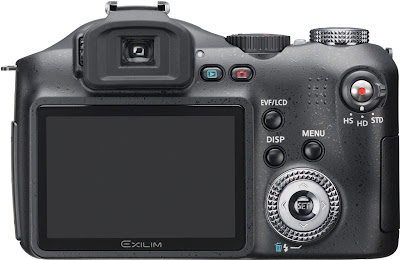
Users can take photographs while, in the monitor, the momentary action that is before their eyes is displayed in slow motion. It is just as if they have slowed down the passing of time. Users can unhurriedly observe the motion of the subject as they press the shutter, ensuring that they never miss that crucial moment.
Rapid Flash
It is possible while using flash to take up to 20 continuous shots at a speed of up to 7 frames per second, so even in low light, no more missed shots. In addition, the internal LED light allows high-speed burst shooting at between 10 and 60 frames per second.
High Speed Movie Recording Up To 1,200 fps
The EXILIM Pro EX-F1 can record high-speed movie footage of motion too fast for the human eye, for ultra slow motion playback. Users can select a recording speed of 300 fps, 600 fps or 1,200 fps. In addition, a Movie Button lets users quickly start movie recording without first switching from still image mode.
Full HD Movies
The camera features Full High-Definition movie recording capability. Users can record beautiful movies at a screen size of 1920 x 1080 pixels, at a rate of 60 fps. The Casio EX-F1 can be connected to an HD compatible television with a separately available HDMI cable to enjoy viewing movies.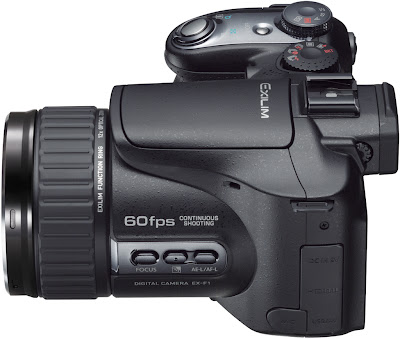 Casio EXILIM Pro EX-F1 specifications
Casio EXILIM Pro EX-F1 specifications
- Sensor: 1/1.8-inch high-speed CMOS Type CCD
- Pixels: 6.6 million total; 6.0 million effective
- Image sizes: 2816 x 2112, 2816 x 1872 (3:2), 2816 x 1586 (16:9), 2304 x 1728, 2048 x 1536, 1600 x 1200, 640 x 480
- STD Movies: 640 × 480 (30 fps)
- HD Movies: 1920 × 1080 (FHD HQ/FHD Normal, 60 fields per second), 1280 × 720 (HD LP, 30 fps)
- Hi-Speed Movies: 512 × 384 (300 fps), 432 × 192 (600 fps), 336 × 96 (1200 fps)
- File formats: Still: RAW (DNG 1), JPEG (Exif Version 2.2), DCF 1.0 standard, DPOF compliant; Movie: MOV format, H.264/AVC, IMA-ADPCM (stereo)
- Lens: 12 lenses in 9 groups, including aspherical lens Approx. 36 to 432mm 35mm equiv. (12x Zoom) F2.7 (W) to 4.6 (T)
- Image stabilization: Sensor-shift
- Operating Speed: High-speed Continuous Shutter: Maximum is 60 frames per second; Flash Continuous Shutter: Maximum is 7 frames per second
- 2.8-inch wide TFT color LCD (Super Clear LCD), 230,160 dots (959 × 240)
- USB/AV port, HDMI Mini Connector (output), hot shoe, external microphone jack, AC adaptor connection (DC-IN); USB : Hi-Speed USB
- Weight (no batt) 671g
- Dimensions 127.7 (W) x 79.6 (H) x 130.1 (D)mm Casio EX-F1 pros and cons
Casio EX-F1 pros and cons
Good
- Full resolution at 60 fps
- Hot shoe
- RAW format
- External mic jack
Bad
- The price at $999 is an excess for SLR-like ultra-zoom cameras
- Mono speaker
- Longest menus ever
- No optical image stabilization in Movie mode
Conclusion
In my opinion, Casio can make much more interesting SLR-like camera than Canon S5 IS or Panasonic Lumix DMC-TZ3. For more details look through Compare digital SLR-like cameras: from Canon S5, Olympus SP 560 and Sony H3, H9 to Panasonic FZ18 and Fujifilm S8000. What is more, the Casio EXILIM Pro EX-F1 is a right choice for those, who need fast digital camera for pets, kids and sport shooting. Moreover, this gadget is not bad for those, who do not want to busy oneself with huge SLR cameras and swapping lenses. There is just one trouble: the Casio EX-F1 costs much more than the Canon S5 IS or even great Fujifilm S9600. However, I hope that declared price about $1000 should be reduced. Or else this gadget cannot be attractive for consumers.
Автор
fototramp
на
10:09 AM
6
комментария(ев)
![]()
Friday, December 21, 2007
Aiptek A-HD and GO-HD camcorders as the best choice for MySpace or YouTube
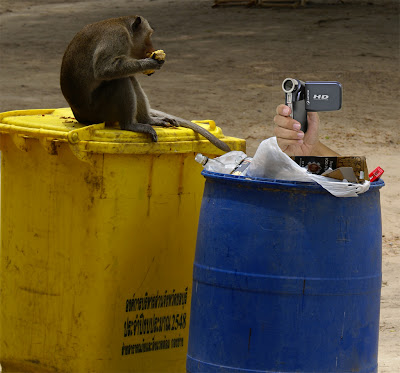 Looking to the Aiptek GO-HD or A-HD it is a little hard to compare these small HD camcorders with some excellent gadgets such as Canon NV20, Panasonic SD1 or Sony CR7. However, even in comparison with Sanyo Xacti family as HD1 and HD2, the Aiptek GO-HD performs good movie quality, especially in low light situations. Though Sanyo HD1 or HD2 and Aiptek GO-HD and A-HD are similar gadgets, it is wrong to call Aiptek cams as a ‘knock-off’ of Sanyo HD camcorders. For more look through: Aiptek GO-HD vs Sanyo Xacti VPC-HD1 or HD2.
Looking to the Aiptek GO-HD or A-HD it is a little hard to compare these small HD camcorders with some excellent gadgets such as Canon NV20, Panasonic SD1 or Sony CR7. However, even in comparison with Sanyo Xacti family as HD1 and HD2, the Aiptek GO-HD performs good movie quality, especially in low light situations. Though Sanyo HD1 or HD2 and Aiptek GO-HD and A-HD are similar gadgets, it is wrong to call Aiptek cams as a ‘knock-off’ of Sanyo HD camcorders. For more look through: Aiptek GO-HD vs Sanyo Xacti VPC-HD1 or HD2.
Aiptek HD: $170 for 720P high definition video
The Aiptek GO-HD and A-HD uses a H.264 compression to achieve a 4.5 Mbps data rate, whereas the VPC-HD2 uses a MPEG4 compression to achieve a 9 Mbps data rate. The H.264 compression is much more computationally intensive than MPEG4 compression, so there must be something fundamentally different about these two camcorders. As for image quality, even though the Go-HD has half the data rate of the VPC-HD2, there are many users’ suggestions that the Aiptek Go-HD has an edge over the VPC-HD2. This fact with Aiptek’s very attractive prices makes the GO-HD for $250 and A-HD for $170 good value for money. For more details look through 12 main points for clever HD camcorder choosing.
Aiptek GO-HD key features
- 5 mega pixels CMOS sensor
- 3x Optical Zoom with Auto Focus
- 2.4" TFT rotational Color LCD Display
- 2-inch Macro Zoom for capturing 5cm close-up pictures or video clips
- Built-in LED lights for video recording in dark and low light situations
- Recharge Battery via USB, no need to remove battery from camera
- HDTV Component Output
- Removable Hard Disk and SD/MMC Card Reader Aiptek GO-HD specifications
Aiptek GO-HD specifications
The GO-HD comprises 1280x720 resolution, 16:9 aspect ratio at 30 fps using advanced H.264 technology. With a 3-x Optical Zoom and Auto-Focus, it can capture not bad quality movie.
- 3-x Optical Zoom lens, 7.5-21.5mm, F 3.6-6.7
- Movie Mode: 1280 x 720 Pixels (H.264) 30 fps, 720 x 480 Pixels (D1) 30 fps, 352 x 240 Pixels (CIF) 30 fps
- MOV Video Format
- Still Images: 2560 x 1920 pixels 5MP, 2048 x 1536 pixels 3MP
- Macro Mode: 5-30cm (at 1x fixed zoom)
- Normal Mode: 30cm - infinity
- LCD Display: 2.4” TFT Panel with 270° Rotation
- External Memory: SD Card Slot (256MB - 8GB)
- TV Out: HDTV (Component Out) NTSC/PAL Color System Supported
- Interface USB2.0
- Battery NP-60 1000mA Li-Ion battery
Aiptek GO-HD pros and cons
Pros:
- Low light video
- Sharp panoramic video
- Video light in addition to flash
- Remote with all options (record video, take picture, zoom, and navigate all menus)
- Good Macro mode
- Tripod mount is right below the lens, which is good for photo stitching
Cons:
- Zooming is loud with noticeable motor noise
- Audio is mono - Cheap feeling
- Cheap feeling
- Poor menu
- Complicated photo/video review (takes a couple of button click to go back and view recently taken footage)
- Battery goes down while it synchronize SD card
- No sequential action snapshot mode
- Can't lock focus and no manual focus
- Grip is awkward and difficult to hold and press buttons
- Date Time setting keeps be reset
- No Lens cover
Of course, the Aiptek GO-HD may not meet the needs of the prosumer enthusiast. However, as an inexpensive digital HD camcorder, which can takes still pictures and has a good 30 fps high definition movie mode, it is a very interesting gadget. For more details look through: Puppet Sanyo Xacti HD2 vs clever Canon HV20 or groovy JVC GZ-HD7: it's time to buy a HD-camcorder or wait?.
Aiptek A-HD key features
The A-HD performs 720P high definition video quality to provide a completely new high quality DV experience. One-touch recording allows you to capture stunning HD 1280 x 720 - 16:9 aspect ratio video clips at 30 frames per second with advanced H.264 technology. The Aiptek A-HD allows using up to 8GB of SD card storage to record longer video before having to upload to PC. - 5 Mega-Pixel CMOS (2592 x 1944) sensor, up to 8MP with still images
- 5 Mega-Pixel CMOS (2592 x 1944) sensor, up to 8MP with still images
- 2-x Digital Zoom
- AV-IN, Record at 720 x 480 (D1) for connecting to TV/VCR/DVD player to record video clips, pictures, and audio recordings
- HDTV Component Output
- Recharge Battery via USB, no need to remove battery from camera
Aiptek A-HD specifications
- Still Image 3200 x 2400 pixels (8MP), 2560 x 1920 pixels (5MP), and 2048 x 1536 pixels (3MP)
- Movie Mode: 1280 x 720 pixels (H.264) 30 fps, 720 x 480 pixels (D1) 30 fps, 352 x 240 Pixels (CIF) 30 fps
- MOV Video Format
- Macro Mode: 30-50cm
- Normal Mode: 50cm - infinity
- 2.4” TFT Panel with 270° Rotation
- Internal Memory: 6MB
- External Memory: SD Card Slot (256MB - 8GB)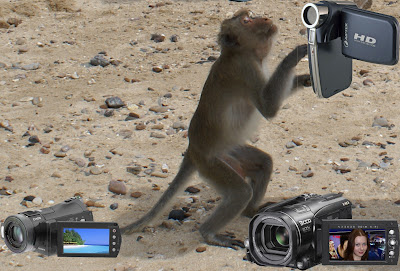 - TV Out HDTV (Component Out) NTSC/PAL Color System Supported
- TV Out HDTV (Component Out) NTSC/PAL Color System Supported
- Interface USB2.0
- Battery NP-60 1000mA Li-Ion battery
- 2GB SD Card allows recording 60 min HD 1280 x 720 movie at 30fps
Conclusion
The Aiptek GO-HD and A-HD are not prosumer cameras such as Sony Handycam HDR-CX7 or Panasonic HDC DX1 / SD1, but they are great for carrying around all the time in a pocket like the Sanyo HD2. Moreover, for $170-250 instead of $800-1000 for CX7 and HDC-SD1, these gadgets can be really useful in some exotic situations, especially when a monkey mixes up your camcorder with a banana. Of course, these HD camcorders look like Christmas toys, but I will be glad to get one of them as a Christmas gift. As for ‘Youtubers’ and ‘Myspacers’, Aiptek GO-HD and A-HD may be not the best, but a cheap and good HD camcorder’s choice.
Автор
fototramp
на
7:43 AM
9
комментария(ев)
![]()
